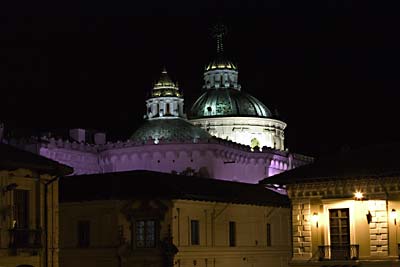
 |
home Jesuits prayer apostolates Rome locator |
The Baroque jewel of the Americas

The historical center of Quito, Ecuador, is a treasure of Spanish colonial architecture that developed in a narrow valley high in the Andes. Out of all the churches and palaces that still draw visitors, one church stands out: not so much for its great size but for the incredible richness of its imagination and design.
"Iglesia de la Compañía" was the center piece for the new "Viceprovincia del Nuevo Reino y Quito" that began in 1605. Construction on the church and adjoining college started with the establishment of the viceprovince which split off from the Jesuit entity of Lima, far to the south. The Superior General of the Society, Father Acquaviva, intended that "the college of Quito would become the first, and would serve as the mother house for creating the Viceprovince which must to expand into the northern regions of South America."
Obviously, such high intentions demanded an appropriately grand building. Neapolitan Jesuit Father Nicolás Mastrilli began construction on the church whose plans are attributed to Domenico Zampieri, who also served as architect for the Chiesa San Ignacio in Rome. Today the city goverment of Quito has taken over most of the original college buildings, but the church remains in Jesuit hands and shines not only as an artistic jewel but as the summit of the Baroque in the Americas.
Jesuits had arrived in Quito in 1586 and found the city offered the best starting point for evangelizing the people who lived in the vast Amazon basin. The high ramparts of the Andes to the north in what is now Colombia made Bogota less inviting as a center, and Lima was too far to the south. The mouth of the Amazon River in Brazil required far too much travel to reach its headwaters. But from Quito Jesuit missionaries had only to cross a few cordillera of mountains before entering the rain forests.
The complex in the heart of the colonial capital contained the church, the Jesuit residence, the Colegio de San Luis, and the university of San Gregorio. Today the collegio is known as Colegio San Gabriel and the university as "La Católica"-with both institutions housed on modern campuses outside the historical center. The residence and the church maintain the long link of Jesuit presence in the heart of the city.
La Compañía follows the basic Baroque pattern established by the Chiesa del Gesú in Rome with a wide central nave flanked by naves on each side and a major retablo behind the main altar. The rich ornamentation and exultant Baroque abundance of details, even in places few people would ever see, owes much to the imagination of Brother Andrea Pozzo, designer of the altar of St. Ignatius in the Gesú and architect of the university church in Vienna. Many Jesuit brothers contributed their talents to La Compañía, including Marcos Guerra, an architect from Naples and Spaniards Miguel Gil del Madrigal and Francisco Ayerdi. George Winterer, a brother from the Tyrol, directed construction of the retablo behind the main altar. Father Leonard Deubler, a German Jesuit, began work on the stone entrance portico which was finished by an Italian brother, Venancio Gandolvi.
The irony is that such an immense undertaking took so long to create that political turmoil overtook spiritual artistry. Deubler began his contribution in 1723 and Gandolvi finished it in 1765, only two years before Charles III of Spain expelled all Jesuits from the lands he ruled. The artistic jewel that grew from the spirit of so many Jesuits was lost just as it was finally completed. Its gold plate was sent to the court of Spain, and the church was alternately closed or cared for by diocesan priests. La Compañía suffered neglect and damage.
Jesuits returned in 1850; within a few years their great energy restored to the church to its original splendor. They had to face other dangers, including earthquakes which destroyed the tower twice (in 1854 and 1868). The president of the republic repaired the tower after the first earthquake but insufficient funds prevented a second restoration. A 1987 earthquake caused serious structural damage, which was being slowly repaired when an accidental fire caused by workers almost destroyed the altar of St. Francis Xavier. Fortunately restores were able to use old plans and photographs to recreate the altar.
People who enter the church today see nothing of the fire, or all the other trials that mark the church's long history. The gold-plated retablo behind the main altar glows dimly in the light entering from the clear windows high up on the walls. Carved and brightly painted bas-reliefs of the four evangelists mark the sides of the cupola, and angels and elaborately-carved IHS's adorn the confessionals that still draw people from all over the city for the sacrament offered by the Jesuits who care for the church. Tourists come, drawn by La Compañía's reputation as one of the most beautiful churches in the continent and as the high point of Latin American Baroque. The faithful come as well, drawn by the Lord whom the church commemorates in an incredibly rich visual imagination.